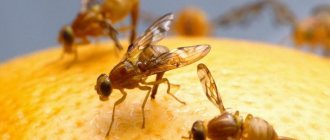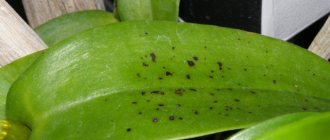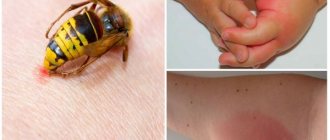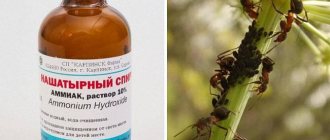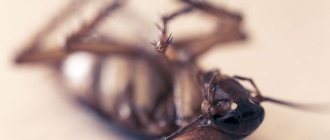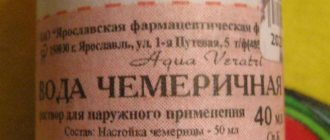Sometimes gardeners are faced with the problem of flies flying around the house. Their number can be very large. But don't panic right away. You must first figure out what kind of insects these are. These could be fungus gnats. Let’s try to figure out how to get rid of them and why they appear in the first place in this article.
Fungus gnats, or sciarids, appear in warm, moist places. These can be ventilation and sewer ducts, basements, bathrooms, closets. Their favorite place is pots with house plants. This is where mosquitoes make their nests. Eggs will appear in them within a few days, and a little later - larvae. You need to fight them very quickly. Moreover, it is necessary to get rid of pests that are in different stages of development at the same time.
What is an insect
The fungus gnat, a photo of which is shown in the figure below, is also called sciara fly. Belongs to the order Diptera, family Sciaridae. The mosquito is a small insect with a narrow oblong body 1.5-4 mm in size. The color is black and gray. Moreover, the color of the body becomes darker as the individual “gets older.” The head is rounded with long antennae. Mouthparts are sucking. Only the front wings are transparent. But they fly well. The hind pair of wings are transformed into club-shaped halteres. Due to this, a characteristic sound can be heard during flight.
Adults do not harm plants. They do not bite or suck blood. They don't get into your eyes. But they can be carriers of various fungal diseases that harm both plants and people.
Life expectancy is approximately a week. But during this time the insect manages to lay up to 300 eggs. The female lays eggs on the surface of moist soil or in the soil between the roots. A few days later, larvae emerge from the eggs. They have no legs and resemble worms.
Fungus gnat larvae are transparent, with a clearly visible intestine and a black “head”. It is the “head” that is the distinctive feature by which sciarids are distinguished from other types of larvae. The length of the larva reaches 8-10 mm. Their mouthparts are gnawing. They feed on plant remains that decompose in the soil. In flower pots when food is scarce, they eat plant roots and young shoots in the soil. This causes irreparable harm to plants. A few days later, pupation occurs and a young midge appears. The remaining shells decompose in the ground. The larvae do not like dry soil. If they are taken out of damp soil into the air, they quickly die.
Sciarids are often confused with Drosophila. If the former have a “slender” body, then the latter are thicker. The mosquito has a head and chest larger than the rest of the body, and a thin abdomen. And Drosophila has no differences between the chest and abdomen.
Description of the sciarid fly (fungus gnat)
Sciara fly , order Diptera, family Sciaridae (sciarids) is a small black-gray mosquito about 1.5 mm long with a narrow body and a rounded head. The insect has only a front pair of transparent wings; the hind wings are transformed into club-shaped halteres. Mouthparts are sucking. They fly well and, in suitable conditions, easily reproduce in large numbers.
| Fungus gnat | A clutch of fungus gnat eggs in a flower pot. | Fungus gnat larvae damage the roots, causing rot. |
Adults do not harm plants, but lay small eggs on the surface of moist soil. Larvae later appear from the eggs - translucent, legless worms with a black “head” measuring 8-10 mm. The mouthparts are gnawing. Typically, the larvae develop in the soil on rotting plant tissue. However, indoor culture often lacks food substrates, as a result of which tender young roots and underground shoots of plants can be gnawed, which poses the main danger.
What is important to know about fungus gnats in order to successfully fight them?
There is no need to panic if large numbers of flying flies suddenly appear at home. First, you should try to figure out who they are and where they came from, and depending on the result obtained, choose a method of getting rid of them.
Do not confuse them with the fruit fly Drosophila! First, look at the flying specimens and make sure that they are sciarids. Mosquitoes, compared to Drosophila, are graceful and slender. The head and chest are larger than the body, the abdomen is thin, about 0.5 mm. Drosophila is a fly, albeit a small one. The abdomen has the proportions of a fly, thicker, without a sharp difference between it and the chest. It appears more often on spoiled fruits, hence the name.
Now, after digging up the soil a little, see if there are sciarid larvae there. If not, then everything is great: it is enough to destroy only the flying mosquitoes, which is not so difficult.
If you do find thin white larval worms with a black head and a segmented body, then this too can be solved. It should be taken into account that worms can also be soil nematodes or young earthworms. At high magnification, it is clear that the body of nematodes is unsegmented, and the head is not prominent in both nematodes and earthworms.
to contents
Reasons for the appearance of insects in the house
Before getting down to the question of how to deal with the fungus gnat, you should figure out why it settled in the house.
The most common causes of flies are:
- Increased humidity in the room.
- Improper care of flowers.
- Purchasing an already charged plant.
Sciarides (fungus gnats) love moist and warm places. They can fly through a window into the light, enter from basements through ventilation, or be in the soil for a flowerpot, garbage or vegetables left for storage (potatoes, carrots for the winter, and so on). Having entered the house, a mosquito can take root if it likes the conditions.
Reasons for appearance
As a rule, flies come to the grower with soil contaminated with their larvae, from which, under favorable conditions, adult flying insects hatch.
It is important to check the quality and carry out preventative treatment of the soil in which you plant the plant, but the presence of flying flies may not be related to your actions.
Often flies are a signal of an unfavorable environmental situation in the house . They did not necessarily come from the pot of a plant standing on the window. Like most insects, midges fly to the light, that is, to the window, next to which they enjoy sitting and flying, but they could have flown in from the outside.
These insects love a warm and humid atmosphere, so they live with great pleasure in damp basements of residential buildings and can visit through hoods, pipes and ventilation shafts, especially in the toilet. Having flown into a gardener’s apartment, they may well take root, laying eggs on the surface of the soil of a recently watered plant and infecting it with their larvae.
Sciarids can also covet food waste (spoiled fruits, vegetables) in the trash can, and linger in the winter vegetable reserves (potatoes, onions). If you are “lucky”, they can find a home in a completely unexpected place, if your apple has rolled somewhere and remained unnoticed, for example, an apple (or its core, which is even worse). Here, treating your flowers with chemicals will not help; you must find and, if possible, eliminate the source.
to contents
Favorite Habitats
If at least one midge appears, you need to check all existing flower pots. They are the most favorite habitats of insects. The first thing to check is plants with moist and well-fertilized soil. If there are a lot of mosquitoes, they can lay eggs in dry soil.
You can check a flower for the presence of sciarids by simply shaking the flowerpot. If there are midges, they will take off in a small flock.
In addition, the fungus gnat can be located in a damp room (bathroom, basement, closet, etc.).
What does an insect look like?
Sciarides are a family of insects. This includes the fungus gnat or, in other words, the sciara fly. The insect represents the order Diptera.
The mosquito is small in size - up to 4 mm. The body is narrow and oblong in shape. The flying insect is black and gray in color. A characteristic feature is that the color becomes darker as they grow older. The fungus gnat has a round head with long antennae. The insect also has colorless fore wings. Despite this, they are endowed with the ability to fly.
The insect has small transparent wings
Signs of the appearance of a fly
A fungus gnat that appears in the house will definitely “show” itself. Several signs will indicate its presence.
Firstly, black insects will start flying around the house. And their location will be mainly flower pots.
Secondly, there will be fungus gnat eggs or larvae in the soil of the flower pots. How to get rid of them is the most important question. And the answer to it depends on the stage of the problem.
A plant that has been attacked by insects will begin to hurt. It weakens, withers, and sheds its leaves. If you do not get rid of pests in time, the flower may simply die. And given the rapid development and reproduction of the fungus gnat, it is necessary to begin fighting it immediately when a problem appears.
Methods for killing fungus gnats
Before getting rid of fungus gnats, it is necessary to study the basic methods and methods of control. Chemicals supplied by popular companies and folk remedies are suitable for these purposes.
Folk remedies
Once the presence of sciarids in potted plants has been established, the humidity level must be reduced. If the number of larvae is large, then a pot with new soil is prepared for the flowers. In this case, you should use an earthen measure.
Among the folk remedies are:
- Treating the soil with pre-dried tobacco. This mixture is administered 4–5 times over 7–8 days.
- The top soil layer is treated with a soap solution. A sprayer is used for this.
- Drainage is introduced into the pot. To prepare it, people use coarse sand or gravel.
- Natural repellents are used to treat vegetation. Experienced gardeners use citrus extracts or anise oil.
- Nepenthes is placed next to infected plants. This plant consumes a variety of insects.
Chemicals
If you have not gotten rid of midges on flowers using folk remedies, the use of chemical compounds is allowed. The rules for their use are described in the instructions supplied by the manufacturers. Among the extensive list are:
- Reid and Neo. Such compositions get rid of midges and flying pests.
- Aktara, Inta-vir and Karbofos. They are prepared in accordance with the recommendations. The resulting solution is used for soil treatment.
- Insecticidal preparations.
You can quickly get rid of fungus gnats if you use proven insecticidal preparations, repellents and folk remedies. Read the instructions before using them. After all, even minor mistakes can cause the death of vegetation.
Preparing to fight insects
Before starting the fight, it is necessary to determine where and at what stage the fungus gnat is located. Control methods for each stage may differ. Therefore, first you need to do some preparatory work that will help achieve maximum effect in the fight against insects:
- First you need to determine the ways in which sciarids enter the house and eliminate them.
- Cover windows with mosquito nets.
- Install protective nets on ventilation ducts.
- Reduce the humidity in the room (you can install additional ventilation).
- Check the soil in the pots and replace it if necessary.
- Check the roots of the plants, remove rotten and damaged areas.
After completing these measures, you can begin the direct destruction of pests.
What do fungus gnats look like?
First of all, if you notice a couple of annoying insects, usually small flies, you need to check all the pots. If at first sciarids appear in pots with a waterlogged substrate, then with intensive reproduction of these insects, moderately moist soil will suit them, and then, if they are hunted, they will agree to fairly dry soil. So you need to check all containers where there is earth.
If you shake or lightly tap a pot with a plant and a flock of flies flies up above the surface of the ground, then most likely there is a clutch of eggs there. If you look closely, you will notice that the flies fly at different ages: light gray ones are still translucent and larger ones are already black. In such a pot, it is better to immediately replace all the soil. Since it has most likely already been processed by worms and is in a rotten state, and, in addition, it is necessary to check the condition of the roots of the plant.
If you take the plant out of the pot and scatter the soil into a tray, then in the damp soil you can see whitish, translucent larvae with a black head, up to 5 mm long. It is much easier to detect the larvae if you water the soil in the affected pot with an insecticide - they usually crawl to the surface, and you can see them writhing.
General wrestling rules
Fungus gnat control will have maximum effect if it is aimed at destroying all forms of insects. These methods include:
- Treatment of the entire room with special aerosols to combat insects (Dichlorvos, Raptor, Raid and others). In this case, it is necessary to remove all food, personal hygiene items and similar items. Pets (birds, fish, puppies, etc.) also need to be isolated for a while.
- Treat window sills, shelves and other places where plants stand. This will help prevent the surviving specimens from developing. The treated areas will then need to be thoroughly washed with soap and water.
- Use insecticides. Among them, the most popular are “Aktellik”, “Aktara”, “Fitoverm”, “Karbofos” and others. The chemical is diluted with water according to the instructions. The resulting solution is used to water the soil in the pots twice at intervals of a week. To prevent the effectiveness of treatment from decreasing, it is recommended not to water the plant for the first days after treatment.
- When fighting larvae, “Bazudin”, “Thunder” and so on will help. When using them, it is necessary to replace the top layer of soil with a mixture of a new substrate with granules of the drug. When watering the plant, the product will dissolve and destroy pests.
Treated plants should be left for several hours (preferably overnight). Later they can be moved to their places. The room must be ventilated and all dead insects removed.
It is necessary to begin pest control when the first individuals appear. If the process is left to chance and the moment is missed, in a few days you will have to fight not only the flying midge. More eggs and larvae will appear, which will also have to be disposed of.
Ways to fight
A set of measures aimed at destroying all forms of fungus gnat
It is not necessary to perform all the suggested actions - determine the extent of damage to your collection and select what is necessary.
Important: approach the problem carefully and carefully. If you fight only larvae or only flying mosquitoes, there will be no benefit. When starting the “battle”, try not to deprive anyone of your attention, and then you are guaranteed success.
- Determine where and how they could get to you and check all possible places where the mosquitoes “reside.” Carefully remove all organic debris and dead parts from the plants.
- If your mosquitoes are coming to you from the basement of your house through hoods, pipes and ventilation shafts, you are very unlucky. It is almost impossible to eliminate dampness in the basement, so mosquitoes, unfortunately, will become your regular guests.
- Install a very fine mesh on the ventilation grilles, through the holes of which mosquitoes will not be able to get into the apartment.
- Check the soil in the pot - if it is heavily infested with larvae, change it to a fresh, breathable soil mixture suitable for the composition of this plant.
- Check the root system of the plant: if there are signs of root rot, take action
- Gather all the plants in one room. It should be well ventilated, and it is better to have a high-quality hood.
- Treat the premises with one of the means against flying insects in the form of an aerosol, for example, “Raptor”, “Raid”, “Neo-dichlorvos”. Make sure that there is no food, utensils, personal items, etc. in the treatment area. Cover the aquarium, remove the cage with birds or small animals.
- Also spray the shelves and window sills on which the plants stand to avoid “revenge” from surviving specimens in the future. Don’t forget to thoroughly clean all surfaces with soapy water and rinse several times with clean water.
- Any available insecticide is suitable for chemicals: Agravertin, Aktara, Inta-vir, Fitoverm, Actellik, Kinmiks, Karbofos. Dilute the working solution according to the instructions and thoroughly water the soil in the pot twice with an interval of 7 days. After treating the soil with a pest control drug, you should not water the plants for at least 3-5 days, so as not to weaken the effect of the drug by reducing its concentration and being washed out of the soil coma.
- For larvae in the ground, soil insecticides are used, for example, Bazudin, Grom-2, Pochin. In pots infested with sciarid larvae, remove the top layer of soil (about 3 cm) and replace it with the following mixture: new breathable soil and several Bazudina granules. Or simply scatter the granules over the surface of the earthen clod and carefully mix them with the top layer. When watering, the drug will dissolve and penetrate into deeper layers, killing the larvae living there. However, it is convenient to use such products if there are few infected plants, otherwise it will take a very long time to lay out and mix the drug in each pot.
- Leave everything for a while, preferably overnight. Close the door tightly and leave the room. In the morning you can move the plants to their places.
- In the room where you carried out the treatment, open the windows or turn on the hood for a long time. Collect the “bodies” of the flying representatives of this pest that fell in the unequal struggle, and clean the premises.
You can get rid of flying insects in several ways:
- Collect with a vacuum cleaner.
- Treat the room with a drug against flying insects in aerosol form (“Raid”, “Neo-dichlorvos”, etc.).
- Use a special sticky fly trap tape, hanging it near the plants. Advice - stock up on sticky fly traps in the summer: in winter there are no traps in stores!
- Use “scotch tape” as a last resort: place small strips with the adhesive side up next to or on the pots.
- Close the windows and turn on one or more fumigators for a long time (depending on the size of the room and the number of plants), placing them as close as possible to the cluster of plants. You can use different plates, “Raid”, “Fumitox”, etc.), the main thing is to change them quite often, about once every 1.5 - 2 hours.
- An unconventional way: plant nepenthes, an insectivorous plant that can now be found in flower shops. It is supposed to “eat” all the midges. In principle, “there is” - it will be there, but not all of them, but only those who want to get into his jug. In addition, Nepenthes itself is not so easy to keep indoors.
- Pour crushed Mashenka chalk (for cockroaches) or draw stripes on the top of the pots.
- Cover the plants with fresh citrus peels, pieces of garlic, branches of incense, sprinkle with dill, and coat the pots with anise oil. All of the above must be updated frequently. This method is effective if a couple of insects accidentally flew into your area and have not yet had time to get used to it, but, unfortunately, this moment is very difficult to detect.
Folk remedies for flying insects:
- Infusion of tobacco or shag - 40 g. dry tobacco infused in 1 liter. water for two days, then filter and add another 2 liters. Water. Spraying must be done 4-5 times every 5-7 days.
- Soap solution - 20-40 g of soap shavings are dissolved in 1 liter. water. Spraying must be done 4-5 times every 5-7 days.
Chemicals to combat flying insects
Flying fungus gnats in flowers can be removed in the following ways:
- Chemical aerosols, which were discussed a little higher.
- Hang fly tape (you can replace it with tape).
- Use a cockroach repellent (such as Mashenka pencil). It is applied to the top of the pot. The second option is to crumble the pencil and sprinkle it around.
How to fight
The fight against such insects must be comprehensive. That is, it is necessary to destroy mosquitoes at all stages of development. There are various methods for controlling sciarids, they are listed in the table.
| Name | Description |
| Special aerosols | The most popular are Raptor, Raid, Dichlorvos. It is better to place food, clothing and other items in a drawer before spraying. Furniture can be wrapped in film. The disadvantage of this method is that you need to leave the room for a while. You should also remember that such aerosols are harmful to pets, so they also need to be isolated for a while |
| Treatment of window sills, shelves and other places with plants | This method is used as a preventive measure against surviving insects. After spraying, wash the area thoroughly with soap and water. |
| Application of insecticides | They use Actellik, Aktaru, Fitoverm, Karbofos. Before use, chemicals should be diluted with water according to the instructions. Next, mix everything thoroughly. The resulting solution is poured into the soil. Course of use – 2 times. The interval between applications should be at least 7 days. For the best effect, it is not recommended to water the plant for 1 - 2 days after use. |
| Fighting sciarid larvae | Bazudin, Thunder will do. The top layer is replaced with a new one containing granules. When watering, the product dissolves and pests are destroyed. |
| Duct tape | Can be bought for flies. If this is not possible, you can use tape |
| Anti-cockroach products | For example, Mashenka’s pencil. It is applied to the top of the pot. Another use is to crumble a pencil and sprinkle it into the soil. |
| Egg fight | You can use Citropak in tablet form. To prepare, you need to dilute the drug in 5 liters of water. Pour the resulting solution into the soil. After the initial treatment, the result will be noticeable. For better results, the procedure can be repeated 1-2 more times. |
How to fight fungus gnats with folk remedies
Among the folk methods of fighting mosquitoes, the most often used are:
- Using a vacuum cleaner, you can collect flying individuals sitting on flowers.
- Only insects that have flown into the room will leave if citrus peels, dill, garlic, and anise oil are placed around the pot.
- Buy a plant that feeds on insects. For example, Nepenthes. The disadvantage of this option is the difficulty of caring for such plants.
- Treat the plant with a soap solution (take 30 g of soap per 1 liter of water). Treatment is carried out 5 times at weekly intervals.
- Tobacco solution can also be used in mosquito control. To do this, infuse 40 g of dry tobacco in 1 liter of water for two days. After time, the solution is filtered and diluted with another 2 liters of water. Use the solution 5 times with an interval of 7 days.
- The use of ash is based on the appearance of an alkaline environment that mosquitoes cannot tolerate. The ash is scattered over the surface of the pot. Under the influence of water (during watering the plant), ash forms an alkaline environment.
What are the folk methods?
In addition to chemicals, there are traditional methods of combating fungus gnats. Most Popular:
- Collecting flying insects using a vacuum cleaner;
You can use a tobacco-based solution
- Place repellent products next to the pot. For example, dill, garlic, orange. With this method, insects will not be able to reproduce. When they enter the house, they will immediately fly away, as the smell frightens them.
- Purchase plants intended for feeding sciarids. For example, Nepenthes. The negative aspects of the technique are that the plant requires complex care.
- To process flowers, use a soap solution. To prepare, mix the ingredient with 1 liter of clean water. The plant needs to be treated at least 5 times with an interval of 7 days.
- Prepare tobacco solution. You need to take the ingredient in dry form and dilute it in 1000 ml of water. Leave for 2 days. Filter and add another 2 liters of liquid. Use the prepared solution up to 5 times. The interval must be at least 7 days.
- Use ash. After application, the environment becomes alkaline and sciarids cannot live in such a place. The ash must be scattered on the surface of the pot. When watering a plant, it will form an alkaline environment.
This video will help you learn more about indoor midges:
Fighting fly eggs
To combat the eggs laid by the fungus gnat, the soil can be shed several times with a weak solution of potassium permanganate.
An effective remedy is the Citropak tablet. Its fourth part is diluted in 5 liters of water. The resulting solution is watered onto the soil. Just one treatment will bring tangible results. But the process can be repeated several more times to consolidate success.
Drying the soil in a pot can also bring positive results. But in this case, it is very important that the plant itself does not die. Its need for water must be taken into account.
Ways to get rid of sciarids
You can destroy sciarid mosquitoes and their larvae using chemicals or proven folk remedies. First of all, it is advisable to try gentle methods, especially when the infection is small.
Folk remedies
If you notice that there are midges in a flower pot, then first of all you need to reduce watering, and if it is severely infested, the flower is removed from the pot, the rotten parts of the root system are removed and replanted in a new substrate.
Advice! Sometimes it is enough to simply change the top layer of soil, but this is only if it is definitely established that the roots are not damaged!
Tobacco. Take 40 g of dry raw material and fill it with a liter of water. We leave everything for 24 hours at room temperature, after which we filter the infusion and add two more liters of water. Spray the above-ground parts of plants and soil with the prepared product. Treatment should be carried out 5 times at weekly intervals.
Soap. To kill midges in flower pots, you can use a soap solution. Rub the bar of soap on a fine grater. Separate 30 g of shavings and add a liter of water, stir until completely dissolved. We spray indoor plants according to the above scheme.
Top drainage. On the surface of the soil we pour a layer of expanded clay, coarse sand or fine gravel, the thickness of which should be about 2 cm. After watering, this layer will always be dry, which will prevent the proliferation of sciarids on indoor flowers, and the roots will be provided with a sufficient amount of moisture.
Potassium permanganate solution. We dilute a small amount of potassium permanganate in water. You should get a light pink solution. Using this product, we spill the soil in the pot several times.
Natural repellents. Some repellents work quite well against flower midges that appear in the apartment, for example, citrus peels and garlic cloves placed near the plants; you can also lubricate the pots with anise oil and sprinkle the surface of the soil with finely chopped dill. Just remember that such tools require constant updating.
Sticky traps. As an additional measure, sticky traps can be used to help get rid of flying insects. They are hung near plants or placed in pots and regularly replaced with new ones.
Getting rid of larvae
The greatest difficulties may arise when getting rid of the larvae deposited by the fungus gnat (photo below). This is due to the fact that the larvae are resistant to most pesticides.
To combat the larvae, you can use soil insecticides (Grom-2, Bazudin, and so on). Their granules are placed in the top layer of soil.
Another surefire way is to keep the top layer of soil in the pot dry. The larvae do not tolerate dry soil.
Folk remedies
An unconventional method that is used to get rid of fungus gnats is to buy a nepenthes plant.
It feeds only on insects and attracts them with its own aroma. The plant is sold in specialized flower shops. The only drawback is difficulty in care.
Important! Nepenthes often dies at home.
You can put fresh citrus peels, garlic cloves, lavender branches, and fresh dill on the soil.
The surface of the pots is treated with anise oil. They need to be updated as needed.
This is an effective method that helps get rid of a small number of insects that have entered the house. If they managed to lay larvae, then citrus peels and lavender will not help.
Infusion of tobacco and shag are additional means that are often used to combat fungus gnats. Take 40 grams of dry tobacco and infuse it in a liter of water for 3 days.
The infusion is filtered and additionally diluted with two liters of water. The liquid is used for spraying indoor flowers.
During the day you need to carry out the treatment up to 5 times, then take a break for 5 days.
Soap solution is a simple and affordable remedy. You need to take 30 grams of fine soap shavings and dissolve them in a liter of water.
During the day, 5 treatments are carried out, with a break of 6 days. To destroy larvae in the soil, use a light solution of potassium permanganate.
Spray the soil with it 2-3 times and do not water the soil for 5 days until it dries out.
Useful video
Garlic can be used as a midge repellent
The moist soil in the mycelium is a wonderful place for the midge family. They try to lay larvae in the top layer of mycelium compost. The death of the larvae will inevitably occur if such places are thoroughly dried and watering is stopped for a while. True, you need to prepare for the fact that part of the mycelium will also die.
Mosquitoes try to fly near light sources. You can try to catch them with a vacuum cleaner. Of course, some of the midges will hide safely, but a significant number will fall into the trap. After this, shake them out of the garbage disposal into a bag and throw them away immediately.
Sticky tape fly traps can also significantly reduce the number of flying pests. Having hung it near the mycelium, all that remains is to observe the trap and change it as necessary.
Orange peel can also be used to repel midges
Mosquitoes do not like strong smells. A few cloves of garlic or orange peels placed on the surface of the mycelium will drive away the midges for a while.
A concentrated infusion of tobacco will help get rid of midges in the mycelium. Infuse a glass of crushed leaves in three liters of water for two days, then generously water the soil. This method will not harm the mushrooms, so it can also be used as a preventative measure.
Fighting flies when growing oyster mushrooms
Mosquitoes are afraid of the smell of laundry soap. By dissolving the block in a bucket of water and generously spraying the room, you can quickly get rid of the flying scourge. It is not necessary to water the soil, but if there are larvae in it, you can treat it with a weaker solution.
We suggest you read: How to fight the Prussians
Preventive actions
It is much more difficult to combat emerging flower pests than to prevent their development. Therefore, it is recommended to pay special attention to preventive measures. They are primarily associated with the elimination of conditions favorable for mosquitoes to live. More precisely, we can highlight the following measures necessary to prevent the occurrence of pests:
- Do not water the plants too much to prevent flooding.
- The water in the trays of the pots should not stagnate.
- When planting plants, use only high quality soil.
- Do not leave “food” for the fly on the plants: dry or damaged leaves, rotten roots, dry inflorescences.
- Grow onions next to flowers, which repel many pests.
Preventive measures
The most important thing in preventing the appearance of insects is to block their access from the outside. To do this, there must certainly be a dense, dense mesh on the ventilation openings. It needs to be replaced with a new one several times a year. You can periodically apply products with an unpleasant odor to the mesh, which insects do not like. If possible, rub it with any pest repellent chalk.
We suggest you read: How to fight subcutaneous mites
Cleanliness of the room and timely cleaning of rotting parts of the mycelium will also help prevent the appearance of insects - mosquitoes will not appear in a sterile environment. Wash all surfaces weekly with lime chloride.
Potassium permanganate solution
Water the compost several times a month with a solution of potassium permanganate. A concentrated mixture is not needed, a slightly pink tint is enough. This will not affect the future harvest, but will effectively protect against uninvited guests.
Regularly replace the topsoil with fresh soil. Compost must be sterilized before use. Also purchase only high-quality soil in specialized stores. Buy mycelium from trusted sellers.
You can get rid of small flying pests in the mycelium, but only by getting to work immediately after detecting them. The effect will increase if the treatment is carried out comprehensively. But it’s even better to prevent insects from appearing by carrying out preventive work.
Timely prevention of the appearance of fungus gnats is the best pest control. The first thing you can do is change the water regime of irrigation and change the watering schedule. In this case, it is best to sharply reduce watering. Remember that the fungus gnat reproduces best in moist soil, and therefore the best control measure is to let the soil in the pots dry out.
To grow indoor plants, you should use only clean substrate that is not contaminated with larvae. Buy packaged soil in specialized stores, and if you prepare the soil for your plants yourself, then you need to be able to process it correctly. To cultivate the land for planting, first it should be well moistened, allowed to drain, and then placed in the freezer to freeze.
